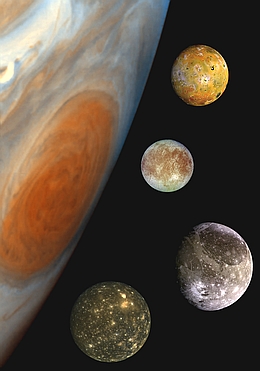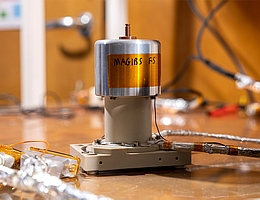Live event to start the JUICE mission at the House of Science. Press release from the Technical University of Braunschweig.
Source: Technical University of Braunschweig 5 April 2023.

The JUICE mission to explore Jupiter and its moons is scheduled to launch on April 13. the Technical University of Braunschweig It is participating in the European Space Agency (ESA) mission with its self-developed magnetometer and camera data processing unit. with Science House Support Program TU Braunschweig accompanies the penultimate launch of the Ariane 5 carrier rocket from the European Spaceport in Kourou, French Guiana. Researchers are particularly interested in Jupiter’s moons Ganymede, Callisto and Europa in order to study the development of habitable worlds around the gas giant.
In 2030 the probe will reach the Jupiter system. Then a three-and-a-half-year investigation period begins. The structure, composition and dynamics of Jupiter’s atmosphere will then be explored. This is followed by a flyby of Jupiter’s moon Europa with a focus on geology and composition. Moreover, the internal structure, surface and outer layer of the atmosphere of Callisto were examined in detail.
Explore the water resources below the surface crust
The final stage of the mission is assigned to Ganymede. To do this, the probe enters a fixed orbit around the moon. In this latter phase, observations of the magnetic field are of particularly high priority, as they can provide valuable information about the interior of the Moon. The goal is to determine the depth and extent of the suspected ocean and to understand the source of Ganymede’s special field and its interaction with Jupiter’s magnetic field.

The Institute of Geophysics and Extraterrestrial Physics at TU Braunschweig is contributing to the measurement campaign with the Fluxgate magnetometer. The project is financially supported by the Federal Ministry for Economics and Climate Protection via the German Aerospace Center. In collaboration with two other magnetometers, it measures magnetic fields in the Jupiter system and especially in the vicinity of Jupiter’s moons. The TU Braunschweig Fluxgate magnetometer is part of the magnetometer package (J-MAG) installed on the spacecraft.
The J-MAG instrument is designed to monitor the subtle magnetic fields emerging from the oceans beneath the lunar surface. Thus, the J-MAG provides a glimpse into the interior of Jupiter’s moons. Furthermore, Jupiter’s Ganymede is of particular interest to J-MAG. It is the only moon known to have a magnetic field of its own. Because of this magnetic field, Ganymede is surrounded by its own micro-magnetosphere, which develops within Jupiter’s massive magnetosphere and dynamically interacts with Jupiter’s magnetic field,” says Professor Ferdinand Blaschke of the Institute of Geophysics and Extraterrestrial Physics.
J-MAG is being developed by a consortium of European universities and research institutes led by Professor Michael Dougherty (Imperial College London). The main players are Imperial College London, the Institute for Geophysics and Extraterrestrial Physics at the University of Braunschweig and the Institute for Space Research in Graz.
The J-MAG instrument package consists of a main electronics box containing all electronic circuit boards of the instrument and three measurement sensors: J-MAG-OB, J-MAG-IB and J-MAG-SCA. Here, J-MAG-OB refers to an external magnetometer developed by Imperial College London, and J-MAG-IB refers to an internal magnetometer developed at the Institute of Geophysics and Extraterrestrial Physics (IGeP) at TU Braunschweig. The third sensor, J-MAG-SCA, is a new type of numerical magnetometer – the so-called dual dark state magnetometer (CDSM) – developed at the Institute for Space Research and the Technical University of Graz. All components are interlocked so that a particularly accurate measuring standard can be achieved.

The optical camera system is examining the lunar surfaces and mapping Jupiter’s clouds
The data processing unit for the JANUS camera was built at the Institute for Data Technology and Communication Networks at TU Braunschweig under the direction of Professor Harald Michalik. It was developed in Italy and Germany, among others, and has the mission of mapping the surfaces of Jupiter’s moons Ganymede, Callisto and Europa in order to be able to examine their geological activity. It can also be used to observe and study cloud formations in Jupiter’s highly organized atmosphere, Jupiter’s ring system, and Jupiter’s smaller moons.
A multispectral camera system with 13 filters in different wavelength ranges will have a resolution of up to 2.4 meters on Ganymede and about 10 kilometers on Jupiter. The data processing unit controls the camera’s electronics and compresses the image data in real time before copying the images into the JUICE spacecraft’s data memory and sending them from there to Earth at a low data rate.
for this event
location:
Auditorium in the Science House, Pockelsstraße 11, Braunschweig
practical:
| 12:00 pm | regards |
| 12:20 p.m | Lecture on the scientific background of juice |
| 13:00 | Lecture on the participation of Braunschweig devices |
| 1:30 p.m | Video conference with Dr. Judge Dr. Oysters at Kourou |
| 1:45 p.m | The telecast from the European Space Agency (ESA) began with Professor Blaschke’s comment |
| 14:15 | Launch the juice mission |
| 15:00 | event end |

“Certified tv guru. Reader. Professional writer. Avid introvert. Extreme pop culture buff.”






More Stories
Samsung Quantum Dot TV: Art meets technology
Pitch: €56m for energy startup Reverion
Plastoplan: Plastics for Energy Transition